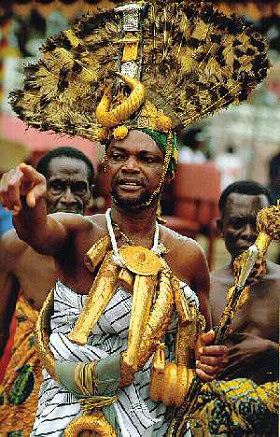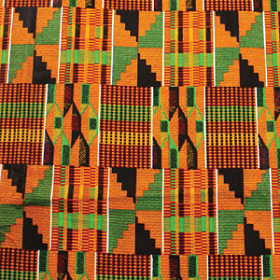- You are here
- Home
- Guide to Africa
- African People and Culture
- African Tribes
- Ashanti People
Ashanti People
Parent page
On this page
Introduction
The Ashanti live in central Ghana in western Africa [map of Ghana ] approximately 300km. away from the coast. The Ashanti are a major ethnic group of the Akans in Ghana, a fairly new nation, barely more than 50 years old. Ghana, previously the Gold Coast, was a British colony until 1957. It is now politically separated into four main parts. Ashanti is in the center and Kumasi is the capital.
To the Ashanti, the family and the mother’s clan are most important. A child is said to inherit the father’s soul or spirit (ntoro) and from the mother a child receives flesh and blood (mogya). This relates them more closely to the mother’s clan. The Ashanti live in an extended family. The family lives in various homes or huts that are set up around a courtyard. The head of the household is usually the oldest brother that lives there. He is chosen by the elders. He is called either Father or Housefather and is obeyed by everyone.
Boys are trained by their fathers at the age of eight and nine. They are taught a skill of the fathers' choice. The father is also responsible for paying for school. Boys are taught to use the talking drums by their mothers' brother. Talking drums are used for learning the Ashanti language and spreading news and are also used in ceremonies. The talking drums are important to the Ashanti and there are very important rituals involved in them. Girls are taught cooking and housekeeping skills by their mothers. They also work the fields and bring in necessary items, such as water, for the group.
Marriage is very important to Ashanti communal life and it can be polygamous. Men may want more than one wife to express their willingness to be generous and support a large family. Women in the Ashanti culture will not marry without the consent of their parents. Many women do not meet their husbands until they are married. Even so, divorce is very rare in the Ashanti culture and it is a duty of parents on both sides to keep a marriage going.
The government of Ashanti is shaped like a pyramid. There is one king and he heads the Ashanti Confederacy Council, a group made of paramount chiefs. A paramount chief presides over district chiefs. A district chief presides over a District Council of Elders, which is made up of subchiefs. Villages are brought together by a subchief. Within every village there is a village head council made up of all the heads of households
The Ashanti religion is a mixture of spiritual and supernatural powers. They believe that plants, animals, and trees have souls. They also believe in fairies, witches, and forest monsters. There are a variety of religious beliefs involving ancestors, higher gods, or abosom, and ‘Nyame’, the Supreme Being of Ashanti. The Ashanti also practice many rites for marriage, death, puberty, and birth. The golden stool is sacred to the Ashanti. There is an elaborate legend surrounding it that is told by the old men of Ashanti. The golden stool is very carefully protected. No one has ever sat on it and since its arrival, it has not touched the ground. As an Ashanti symbol, the golden stool represents the worship of ancestors, well-being, and the nation of Ashanti.
The Ashanti have a wide variety of arts. Bark cloth was used for clothing before weaving was introduced. With weaving, there is cotton and silk. Women may pick cotton or spin materials into thread, but only men are allowed to weave. There are different patterns in weaving, each with its own name. Sometimes the pattern represents social status, a clan, a saying, or the sex of the one wearing it. Patterns are not always woven in the cloth. It can also be stamped on in many designs. Pottery is a skill that is taught to a daughter by the mother. There are many stages to making pots and there are many colors of clay available. The Ashanti also do woodcarving and metal casting.
Written By: April West
Ashanti Stools
As a symbol of nationhood, and because if contains the sumsum or Soul of Ashanti (Asante), the Golden Stool is considered to be so sacred that no person whatsoever is allowed to sit upon it. It is kept with the strictest security and precaution; and is taken outside only on exceptionally grand occasions. Never must it come in contact with the earth or the ground. It is always lying on its own stool or on the skin of an animal such as the leopard. Ashantis have on many occasion made great sacrifices to defend it when its safety had been threatened. In 1896 they submitted to the deportation of their King, Prempeh I, rather than resort to a war in which they feared they might suffer defeat and risk the loss of the Golden stool. They deemed the loss of their King a small thing compared with the loss of their Golden Stool.
Kente Cloth
Kente cloth has a history going back over 400 years and was the cloth of Kings and still is traditional a ceremonial cloth hand-woven on a horizontal treadle loom. Strips measuring about 4 inches wide are sewn together into larger pieces of cloths.
Cloths come in various colors, sizes and designs and are worn during very important social and religious occasions. In a total cultural context, kente is more important than just a cloth. It is a visual representation of history, philosophy, ethics, oral literature, moral values, social code of conduct, religious beliefs, political thought and aesthetic principles.
The term kente has its roots in the word kenten which means a basket. The first kente weavers used raffia fibers to weave cloths that looked like kenten (a basket); and thus were referred to as kenten ntoma; meaning basket cloth. The original Asante name of the cloth was nsaduaso or nwontoma, meaning "a cloth hand-woven on a loom" and is still used today by Asante weavers and elders. However, the term kente is the most popularly used today, in and outside Ghana.


